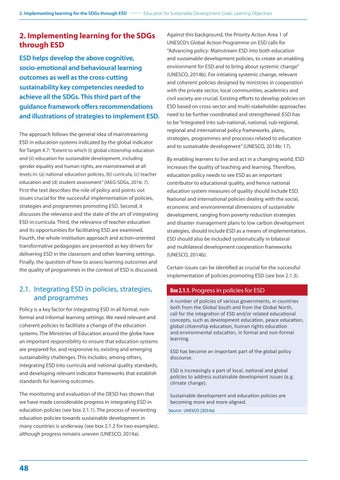2. Implementing learning for the SDGs through ESD
Education for Sustainable Development Goals: Learning Objectives
2. Implementing learning for the SDGs through ESD ESD helps develop the above cognitive, socio-emotional and behavioural learning outcomes as well as the cross-cutting sustainability key competencies needed to achieve all the SDGs. This third part of the guidance framework offers recommendations and illustrations of strategies to implement ESD. The approach follows the general idea of mainstreaming ESD in education systems indicated by the global indicator for Target 4.7: “Extent to which (i) global citizenship education and (ii) education for sustainable development, including gender equality and human rights, are mainstreamed at all levels in: (a) national education policies, (b) curricula, (c) teacher education and (d) student assessment” (IAEG-SDGs, 2016: 7).
First the text describes the role of policy and points out issues crucial for the successful implementation of policies, strategies and programmes promoting ESD. Second, it discusses the relevance and the state of the art of integrating ESD in curricula. Third, the relevance of teacher education and its opportunities for facilitating ESD are examined. Fourth, the whole-institution approach and action-oriented transformative pedagogies are presented as key drivers for delivering ESD in the classroom and other learning settings. Finally, the question of how to assess learning outcomes and the quality of programmes in the context of ESD is discussed.
2.1. Integrating ESD in policies, strategies, and programmes Policy is a key factor for integrating ESD in all formal, nonformal and informal learning settings. We need relevant and coherent policies to facilitate a change of the education systems. The Ministries of Education around the globe have an important responsibility to ensure that education systems are prepared for, and responsive to, existing and emerging sustainability challenges. This includes, among others, integrating ESD into curricula and national quality standards, and developing relevant indicator frameworks that establish standards for learning outcomes. The monitoring and evaluation of the DESD has shown that we have made considerable progress in integrating ESD in education policies (see box 2.1.1). The process of reorienting education policies towards sustainable development in many countries is underway (see box 2.1.2 for two examples), although progress remains uneven (UNESCO, 2014a).
48
Against this background, the Priority Action Area 1 of UNESCO’s Global Action Programme on ESD calls for “Advancing policy: Mainstream ESD into both education and sustainable development policies, to create an enabling environment for ESD and to bring about systemic change” (UNESCO, 2014b). For initiating systemic change, relevant and coherent policies designed by ministries in cooperation with the private sector, local communities, academics and civil society are crucial. Existing efforts to develop policies on ESD based on cross-sector and multi-stakeholder approaches need to be further coordinated and strengthened. ESD has to be “integrated into sub-national, national, sub-regional, regional and international policy frameworks, plans, strategies, programmes and processes related to education and to sustainable development” (UNESCO, 2014b: 17). By enabling learners to live and act in a changing world, ESD increases the quality of teaching and learning. Therefore, education policy needs to see ESD as an important contributor to educational quality, and hence national education system measures of quality should include ESD. National and international policies dealing with the social, economic and environmental dimensions of sustainable development, ranging from poverty reduction strategies and disaster management plans to low carbon development strategies, should include ESD as a means of implementation. ESD should also be included systematically in bilateral and multilateral development cooperation frameworks (UNESCO, 2014b). Certain issues can be identified as crucial for the successful implementation of policies promoting ESD (see box 2.1.3).
Box 2.1.1. Progress in policies for ESD A number of policies of various governments, in countries both from the Global South and from the Global North, call for the integration of ESD and/or related educational concepts, such as development education, peace education, global citizenship education, human rights education and environmental education, in formal and non-formal learning. ESD has become an important part of the global policy discourse. ESD is increasingly a part of local, national and global policies to address sustainable development issues (e.g. climate change). Sustainable development and education policies are becoming more and more aligned. Source: UNESCO (2014a)


